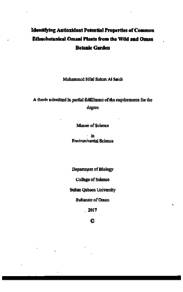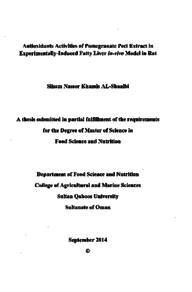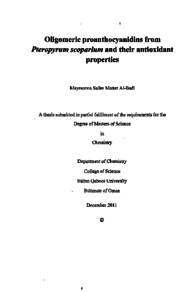Document
Identifying antioxidant potential properties of common ethnobotanical Omani plants from the wild and Oman botanic garden.
Publisher
Sultan Qaboos University
Gregorian
2017
Language
English
Subject
English abstract
Phytonutrients (phenolic compounds and flavonoids) are secondary plant metabolites and play a significant role in defense system against pathogens as well as protection from oxidative injury due to their potential ability to neutralize reactive oxygen species including peroxides. Total phenolic content (TPC), total flavonoid content (TFC), the total antioxidant capacity (TAC), scavenging activity against H2O2 as well as brine shrimp (Artemia salina) lethality of aqueous extracts of commonly used native plants from wild and Oman Botanic Garden (OBG) were evaluated. The studied plants were reported to have wide ranges in the investigated parameters. The TPC ranged from 0.52 to 65.14 mg GAE/ g dry solid while TFC ranged from 0.07 mg to 37.14 mg CE/ g dry solid. In addition, TAC ranged from 168.27 to 1046.84 umol TE/ g and the percentages of scavenging activity spanned from 6.9 to 91.9 %. Among a total of 30 plant species examined, Pteropyrum scoparium (PS), Moringa peregrina (MP), Dodonaea viscosa (DV), Rhus aucheri (RA), Acridocarpus orientalis (AO) and Prosopis cineraria (PC) showed high values in almost all parameters. Significant positive correlation coefficients obtained between TPC and TFC and TAC and scavenging activity suggest contribution of phenolics and flavonoids to the overall antioxidant properties of the aqueous extracts. The plants from the wild and OBG exhibited variability in TPO and TFC. Several factors (e.g. abiotic and developmental stages of some sampled plants) were suggested and discussed for influencing their secondary metabolites production, but the study was not conclusive on a specific factor. Nevertheless, there was no significant difference in TAC between plants species from the wild and OBG. At the exposure levels of Ito 1000 ug/ml, the lethality brine shrimp test of four plants (M. peregrina, P. scoparium, R. aucheri and P. cineraria) having the highest values in TPC, TAC and scavenging activity revealed that they may be safe for consumption as food or medicine. In general, the results of our study revealed that some Omani plant species might be considered as potential sources for production of phenolic compounds and flavonoids. These plants can be propagated and their secondary metabolites may be utilized in food and nutraceutical industry, It is also recommended to include these plants species in the food chain of the Omani population as a dietary intervention to combat oxidative stress-mediated human chronic diseases.
Member of
Resource URL
Arabic abstract
تعتبر العناصر الغذائية النباتية (المركبات الفينولية والفلافونويدات) نواتج أيضية نباتية ثانوية وتلعب دورا هاما في نظام الدفاع ضد مسببات الأمراض وكذلك الحماية من الإصابة الناتجة من عمليات الأكسدة نظرا لقدرتها على معادلة جزيئات الأكسجين عالية التفاعل بما في ذلك البيروكسيدات (peroxides). في هذه الدراسة، تم تقييم المستخلصات المائية للنباتات العمانية المستخدمة محليا على نطاق واسع لتحديد إجمالي المحتوى الفينولي (TPC)، وإجمالي محتوى الفلافونويد (TFC)، والقدرة الكلية المضادة للأكسدة (TAC)، والفاعلية ضد بيروكسيد الهيدروجين (H202) وكذلك سميتها على أحد الكائنات الحية (Artemia salina) تم تجميع النباتات من البرية وحديقة النباتات والأشجار العمانية. وأظهرت الدارسة أن لدى النباتات مدى عريض لقيم الخصائص التي تم قياسها. فعلى سبيل المثال، تراوح إجمالي المحتوى الفينولي (TPC) من 0 . 52 إلى 65 . 14 ملغ معادل حمض الجاليك جرام من مادة النبات الصلبة في حين تراوح إجمالي محتوى الفلافونويد (TFC) من 0 . 07 إلى 37 . 14 ملغ معادل الكاتشين جرام. كما تراوحت القدرة الكلية المضادة للأكسدة (TAC) من 168 . 27 إلى 1046 . 84 میکمول معادل ترولوكس جرام، والفاعلية ضد بيروكسيد الهيدروجين (H 02) كانت بين و6 و % 91 . 9 . من بين 30 نوعا من النباتات التي تم فحصها، أظهرت كل من السيدان Pteropyrum scoparium (PS) ,الشوع (Moringa peregrina ( MP ,الشحص (Dodonaea viscosa ( DV ,القطف Rhus ( aucheri ( RA ,القفص (Acridocarpus Orientalis ( A0 و الغافة (Prosopis cineraria ( PC قيم عالية في أغلب الخصائص التي تم قياسها. كما أظهرت الدراسة وجود معاملات ارتباط ايجابية بين إجمالي المحتوى الفينولي (TPC)، وإجمالي محتوى الفلافونويد (TFC)، والقدرة الكلية المضادة للأكسدة (TAC) والفاعلية ضد بيروكسيد الهيدروجين وذلك بسبب مساهمة الفينولات والفلافونويدات في خصائص مضادات الأكسدة المستخلصات المائية النباتية. ولقد لوحظ تباين في قيم كل من إجمالي المحتوى الفينولي (TPC)، وإجمالي محتوى الفلافونويد (TFC) بين النباتات التي تم الحصول عليها من البرية و حديقة النباتات والأشجار العمانية . وذلك بسبب تأثير عدة عوامل (مثل العوامل غير الحيوية ومراحل النمو لبعض النباتات المأخوذ منها العينات) على النواتج الأيضية الثانوية، ولكن الدراسة لم تكن حاسمة في تحديد عامل معين . ومع ذلك، لم يكن هناك فرق پر في القدرة الكلية المضادة للأكسدة (TAC) بين الأنواع النباتية المأخوذة من كل من البرية و حديقة النباتات والأشجار العمانية . اظهر اختبار السمية للمستخلصات النباتية لتراكيز تراوحت من 1 إلى 1000 ميكروغرام مل لأربع نباتات ( M . peregrina P . cineraria , R . aucheri P . Scoparium ) ذات قيم عالية في إجمالي المحتوى الفينولي (TPC)، والقدرة الكلية المضادة للأكسدة (TAC)، والفاعلية ضد بيروكسيد الهيدروجين (H202) على أنها قد تكون آمنة للاستهلاك كغذاء أو دواء. وبصفة عامة، أظهرت نتائج دراستنا أن بعض أنواع النباتات العمانية يمكن اعتبارها مصدرا محتملا لإنتاج المركبات الفينولية والفلافونويدات. ويمكن اكثار هذه النباتات واستخدام نواتجها الأيضية الثانوية في صناعة الأغذية والمواد المغذية. كما يوصي ايضا بإدراج هذه الأنواع النباتية في السلسلة الغذائية للسكان العمانيين كتدخل غذائي لمكافحة الأمراض المزمنة التي قد تنشا بسبب الإجهاد التأكسدي .
Category
Theses and Dissertations



